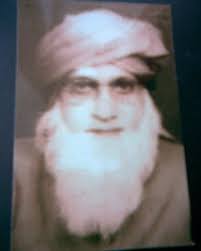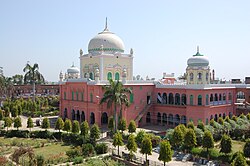Ilyas Kandhlawi
 From Wikipedia - Reading time: 9 min
From Wikipedia - Reading time: 9 min
Muhammad Ilyas Kandhlawi | |
|---|---|
 | |
| 1st Amir of Tablighi Jamaat | |
| Succeeded by | Muhammad Yusuf Kandhlawi |
| Title | Founder of Tableeghi Jamaat |
| Personal | |
| Born | Akhtar Ilyas 1885 (1302 Hijri year) |
| Died | July 13, 1944 (aged 58–59) (1363 Hijri year) |
| Religion | Islam |
| Denomination | Sunni |
| Jurisprudence | Hanafi |
| Movement | Deobandi |
| Main interest(s) | Da'wah |
| Notable work(s) | Tablighi Jamaat |
| Alma mater | Darul Uloom Deoband |
| Occupation | Da'i |
| Muslim leader | |
| Disciple of | Rashid Ahmad Gangohi Muhammad Ismail Kandhlawi Khalil Ahmad Saharanpuri Muhammad Yahya Kandhlawi |
Influenced by
| |
Influenced
| |
| Part of a series on the |
| Deobandi movement |
|---|
 |
| Ideology and influences |
| Founders and key figures |
|
| Notable institutions |
| Centres (markaz) of Tablighi Jamaat |
| Associated organizations |
Muḥammad Ilyās ibn Muḥammad Ismā‘īl Kāndhlawī Dihlawī (1885 – 13 July 1944) was an Indian Islamic scholar of the Deobandi movement who founded the Tablighi Jamaat, in 1925, in Mewat province.[1][2]
Early life and education
[edit]Muhammad Ilyas was born in 1303 AH (1885/1886) in the village of Kandhla, Muzaffarnagar district, North-West Provinces, British India (in present-day Shamli district, Uttar Pradesh, India). His year of birth can be computed by the tarikhi (chronogrammatic) name "Akhtar Ilyas" (اختر الیاس) using abjad numerals.[3][4]
In a local maktab (school), he memorized one and a quarter ajza' of the Qur'an, and he completed memorizing the Qur'an under his father's supervision in Nizamuddin area, Delhi. Thereafter, he studied the elementary books of Arabic and Persian language mostly under his father. Later on, he lived with and studied under Rashid Ahmad Gangohi. In 1905, Rashid Ahmad Gangohi died, when Muhammad Ilyas was 20. In 1908, Muhammad Ilyas enrolled in Darul Uloom Deoband. He also studied under Mahmud Hasan Deobandi.[5]
Foundation of Tablighi Jamaat
[edit]In the early 1920s, he prepared a team of young madrasah graduates from Deoband and Saharanpur and sent them to Mewat to establish a network of mosques and Islamic schools movement.[citation needed] He once said that if he had to attribute a name to his movement, it would have been Tehreek-e-Imaan ('Imaan/Faith movement'). The people of South Asia started calling the devotees Tableeghi and this name eventually became popular among the common people.[6] The Tablighi Jamaat has since gone on to become one of the most widespread grassroots Islamic movements in the world with a presence in many countries, including Canada, South Africa and the UK.[7]
Legacy
[edit]Abul Hasan Ali Hasani Nadwi wrote a biography named Life and mission of Maulana Mohammad Ilyas.
References
[edit]- ^ "Deobands battle for survival". Dawn. Pakistan. 3 December 2009. Retrieved 27 February 2020.
- ^ Alper, Ömer Mahi̇r (1988–2016). "KANDEHLEVÎ, Muhammed İlyas". TDV Encyclopedia of Islam (44+2 vols.) (in Turkish). Istanbul: Turkiye Diyanet Foundation, Centre for Islamic Studies.
- ^ Sayyid Abul-Ḥasan ‘Alī Nadwī (n.d.) [First published c. 1947]. حضرت مولانا محمد الیاس اور ان کی دینی دعوت / Ḥaẓrat Maulānā Muḥammad Ilyās aur un kī dīnī da'wat (in Urdu). Rā’ewind [Raiwind]: Maktabah Maḥmūdīyah.
- ^ "Maulana Ilyas Kandhlavi". Great Personalities in Islam. Adam Publishers & Distributors. 2004. ISBN 9788174351227. Retrieved 7 May 2020.
- ^ Jaleel, Talib (11 July 2015). Notes On Entering Deen Completely: Islam as its followers know it. Retrieved 7 May 2020.
- ^ "Tablighi Jamaat traces its origins to the Mewat region". Retrieved 7 May 2020.
- ^ Timol, Riyaz (14 October 2019). "Structures of Organisation and Loci of Authority in a Glocal Islamic Movement: The Tablighi Jama'at in Britain". Religions. 10 (10): 573. doi:10.3390/rel10100573.
Further reading
[edit]- Nadwi, Abul Hasan Ali Hasani (2001). Shafi, Muhammad (ed.). Urdu Daira Maarif Islamiya (PDF) (in Urdu). Vol. 19. Lahore, Pakistan: University of the Punjab. pp. 373–375.
- Nadwi, Abu'l-Hasan `Ali. Life and Mission of Maulana Muhammad Ilyas.
- "Profile of Maulana Mohammad Ilyas Kandhlawi". Madrasa Islamia Arabia Khadimul-Uloom Baghonwali and Bajheri. Archived from the original on 12 February 2019. Retrieved 3 May 2017.
- Yoginder Sikand (17 April 2010). "The Tablighi Jamaat in Mewat -- Part 2". TwoCircles.net. Retrieved 3 May 2017.
 KSF
KSF